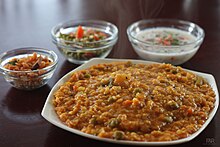


Fresh bisi bele bhath
| |
| Place of origin | Karnataka, India |
|---|---|
Bisi bele bhath (Kannada: ಬಿಸಿ ಬೇಳೆ ಭಾತು, romanized: bisi bēl̥e bhātu, lit. 'hot lentil [boiled] rice') or bisi bele huliyanna (ಬಿಸಿ ಬೇಳೆ ಹುಳಿಯನ್ನ) is a spicy, rice-based dish with origins in the state of Karnataka, India.[1] It is said to have originated in the Mysore Palace[2] and it took a 100 years for the dish to come out of the palace kitchens and another 200 years to spread across the state of Karnataka.[3]

The traditional preparation of this dish is quite elaborate and involves the use of a spicy masala (huliyanna), toor dal (a type of lentil), rice, ghee and vegetables.[4] Spices like nutmeg, asafoetida, curry leaves and tamarind pulp contribute to its unique flavour and taste. Some versions of the dish are prepared with up to thirty ingredients.[5]
It is served hot and sometimes eaten with chutney, boondi, salad, papad, or potato chips. This dish is commonly found in restaurants that serve the Udupi cuisine. The masala used is available off the shelf.
This Karnataka-related article is a stub. You can help Wikipedia by expanding it. |